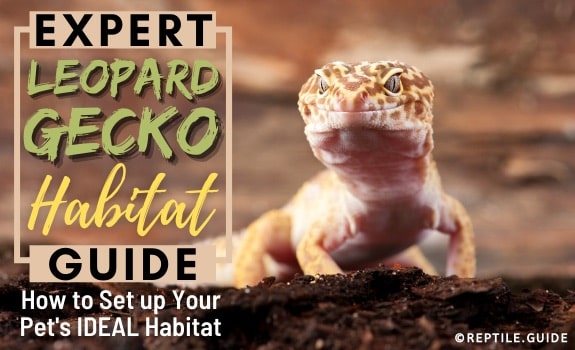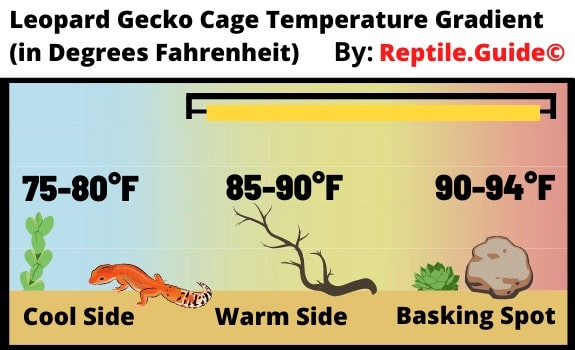Leopard geckos are small, cute, terrestrial lizards native to the hot, arid deserts of Afghanistan, Pakistan, India, and Iran.
Their simple husbandry requirements, calm temperament, silly antics, and petite size make them an ideal pet for many people.
The first, and perhaps MOST important step for a new leopard gecko owner is to plan and set up a proper leopard gecko habitat.
A great set-up is vital for your pet’s mental and physical well-being.
Improper temperatures will cause digestive issues. Incorrect humidity will cause infections. Improper decor could cause injuries. You get the idea.
This might sound overwhelming at first, but don’t worry!
Fortunately, all it takes is a basic understanding of leopard geckos habitat in the wild (and their behavior) to be able to provide an excellent replica habitat for captive living.
A MAJOR component of knowing how to properly care for a leopard gecko (opens in a new tab) involves nailing their habitat.
So, rest assured, I’ve broken down EVERY significant aspect of your leopard gecko’s habitat in a way that’s easy to understand and realistic to implement.
Curious or in a hurry?
✅ Here’s my go-to leopard gecko habitat shopping list which contains my MOST recommended products.
✅ Need an entire setup now? Here’s a leopard gecko starter kit you can trust.
In This Article
Leopard Gecko Enclosure

Before you pick out a name, activate your inner interior designer, and feng shui the heck out of your leopard gecko’s habitat, you’ll want to first weigh your options.
In fact, you’ll need to consider a handful of factors when you’re trying to decide on your gecko’s enclosure.
Size and material are the most obvious factors, but consider ask yourself these questions, too:
Do you want your enclosure to open from the top or the front? Enclosures that open from the top, usually aquariums, are easier to find and often cheaper, but they may make your leopard gecko more nervous. It could view you as a predator coming from the sky when you reach in.
How do you want to heat your enclosure? Decide if you wish to use belly heat, overhead heating, or a combination. You’ll need to get creative if you want to install belly heat in a solid-bottomed enclosure or install mounting hardware for overhead heating in a solid-topped enclosure.
When determining the enclosure size that you will purchase or make, keep in mind that most leopard geckos will spend at least 95% of their lives in this habitat.
Bigger is better for keeping your lizard happy, healthy, and entertained.
If you plan on cohabitating more than one leopard gecko, make sure to provide adequate space to avoid territorial conflicts. Many reptile keeping experts advise against cohabitating any sex of leopard gecko; of course, there are inherent risks.
Still, evidence suggests that wild leopard geckos live in loosely formed colonies. Do your research and make your choice ahead of time so that you can select an appropriately sized habitat.
Bigger enclosures will inevitably be more expensive.
Another cost-related factor to consider is that larger enclosures will require a higher-powered heating device and, potentially, more than one heat source.
Since leopard geckos are terrestrial, the height of their enclosure isn’t a vital aspect. Excessive vertical space can cause heating difficulties.
However, the habitat should still be tall enough for your pet to keep a safe distance from the heat source.
You could utilize extra cage height with ramps and shelves, creating more opportunities for thermoregulation and enrichment.
At a minimum, provide your leopard gecko with at least two and a half square feet of floor space. This is the equivalent of a twenty-gallon long aquarium. Provide an additional two square feet of floor space per additional gecko, if you decide to house a small colony together.
In regard to enclosure material, there are pros and cons to every option. It usually comes down to a matter of your personal preference and circumstances….
Wooden Leopard Gecko Enclosures
Wooden enclosures are better insulated to hold in heat, but you’ll need to ensure adequate ventilation to avoid high humidity.
Belly heat installation will require some ingenuity since your pet shouldn’t be allowed to come in direct contact with the heat source. However, the heat will not be able to penetrate a thick layer of wood.
You can use screws to install anything that needs to be mounted, from heating and lighting fixtures to ramps and shelves.
Visibility is usually limited to the front side only, but this may help your leopard gecko feel more secure.
If you’re experienced with DIY projects, you can generally save a lot of money by making your own wooden enclosure.
Glass Leopard Gecko Enclosures
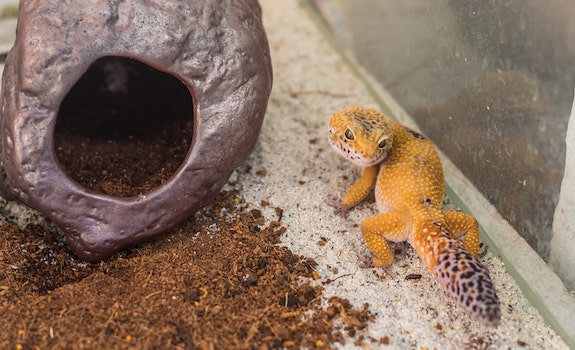
Glass enclosures are easier to find and usually cheaper.
You’ll be able to mount overhead heating and lighting on a screen lid or with a mount that clips onto the lip of the habitat. Belly heat installation is simple and straightforward.
Front-opening terrariums are pricier than aquariums that are open on the top.
Anything that needs to be mounted inside will probably require the use of suction cups.
Plastic Leopard Gecko Enclosures
Plastic reptile enclosures offer many of the same benefits and drawbacks of wooden enclosures…
Like glass, they’re resistant to mold and easy to sanitize, unlike wood.
Unfortunately, plastic reptile enclosures typically cost more than glass or DIY wooden enclosures of equivalent size.
The plastic can be either see-through acrylic or solid-colored PVC.
Buyer’s Tip
✅ Looking to purchase a plastic leopard gecko enclosure? This one is my favorite!
✅ Need your enclosure ASAP? This glass leopard gecko enclosure is a great option.
Leopard Gecko Temperature & Lighting Setup
Like most reptiles, leopard geckos require a temperature gradient in their home.
This allows them to thermoregulate or select the appropriate temperature at any given moment for digestion, rest, and exploration. There should also be a designated basking spot.
Heating can come from belly heat, overhead heat, or both. It’s debatable which source is more beneficial for leopard geckos.
On one side of the argument, leopard geckos are terrestrial, and they are built low to the ground, so belly heat is the most efficient way to provide them with warmth.
Belly heat can come from heat tape, heat rope, or a reptile heating pad.
On the other hand, in nature, heat comes from the sun in the sky. Overhead heating is the best way to replicate this.
Overhead heating can come from a lightbulb, a UVB basking bulb, a ceramic heat emitter, or a radiant heating panel.
Whichever source of heat you use, always install it to a thermostat to ensure that your pet’s enclosure doesn’t get too hot. Utilize strategically placed digital probe thermometers to monitor the temperature of various areas of the habitat.
Although not required, studies have shown that reptiles may benefit from a nighttime temperature drop to help them regulate their natural day and night cycles.
If you wish to keep your pet in as natural conditions as possible, set your heat sources up on a timer to turn off for ten to twelve hours at night.
✅ Buyer’s Tip: Unfortunately, some probe and dial thermometers can be notoriously inaccurate (sometimes as much as 20 degrees!). Using a more reliable infrared temperature gun ensures that your thermometers are showing accurate temperatures.
Here are the temperatures to aim for:
Cool Side Temperature: 75-80°F
Warm Side Temperature: 85-90°F
Basking Spot Temperature: 90-94°F
Nighttime Temperature: 60-74°F
Lighting isn’t required for a leopard gecko’s survival. It can still offer benefits in regard to their natural behavior, mental well-being, appetite and feeding pattern, and day and night cycle.
However, light can still be provided for up to fourteen hours a day.
If you’d like to stimulate the natural, seasonal light cycle, you can leave the light on for fourteen hours during the Summer and twelve hours during the Winter. Plugging the lighting into a timer is the easiest way to achieve this cycle.
If you’re housing your leopard gecko in an enclosure with at least one transparent side, the room light and natural light from windows may be enough.
Leopard geckos are crepuscular, meaning they’re most active during dusk and dawn. Otherwise, they’re usually more active during the night, so don’t be worried if your pet hides all day while the light is on.
It’s also not unheard of for them to come out and bask during the day. This is all beneficial, natural behavior.
Unlike most other lizards, leopard geckos won’t get sick without UVB lighting. Still, this is a natural wavelength that, although not necessary, offers digestive benefits and a natural source of Vitamin D.
Although not necessary, UVB will help your leopard gecko to absorb calcium efficiently. Keepers that provide their gecko with UVB lighting report observing their leopard gecko basking under the daytime light occasionally.
Leopard gecko morphs that have reduced pigment and pattern like Albino leopard gecko will require weaker UVB bulbs because they’re prone to burns from a high UV index.
Black, red, and blue reptile lights offer NO benefits to your leopard gecko, and they may be harmful to their eyes and day/night cycle.
If you need to provide supplemental heating at night, opt for belly heat, a ceramic heat emitter, or a radiant heating panel.
Leopard Gecko Humidity
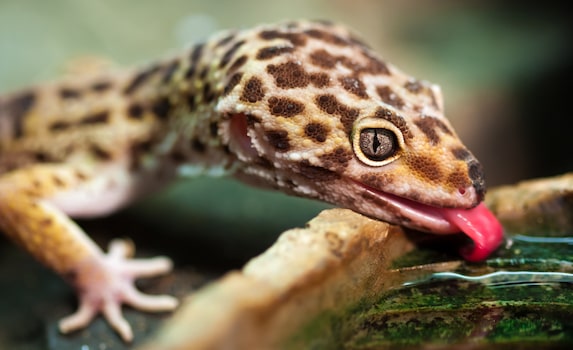
Given their arid native lands, leopard geckos are best kept in an overall low humidity range – between 20% to 40%. This usually matches the ambient humidity of typical homes.
An enclosure with a screen lid will allow moisture to evaporate from the top, keeping the humidity low.
Excessively high humidity levels in the enclosure can contribute to respiratory infections and skin infections.
Bacteria and fungi LOVE warm, moist environments, so they will thrive on surfaces in the enclosure and even in and on your poor leopard gecko!
If you are having a hard time keeping the humidity level low enough, try:
- Using a smaller water bowl
- Keeping the water bowl on the cool side of the enclosure
- Using a dehumidifier in the room
- Running a fan in the room
- Using a screen top
- Increasing ventilation in solid-sided enclosures
- Removing live plants
- Avoiding loose substrates
Despite the need for an overall low humidity level, leopard geckos NEED a hide with high humidity to help them shed.
Shedding difficulties are among the most common issues that captive leopard geckos (and their keepers) battle.
The easiest way to make a humid hide is by cutting a small hole in a food storage container. Make the hole large enough for your leopard gecko to fit inside. The larger the hole is, the more moisture will escape. Make sure the edges of the hole aren’t sharp!
Inside the hide, put wet paper towels, sphagnum moss, or coconut coir. Place this hide on the warm side of the enclosure.
The added warmth will release the water from the substrate, raising the air’s humidity inside the hide – but not in the entire enclosure.
Monitor the humidity level inside the hide with a digital probe hygrometer. It should hover between 70% and 80% humidity.
Check the hide DAILY to ensure that it hasn’t dried out or started to grow mold.
Leopard Gecko Substrate
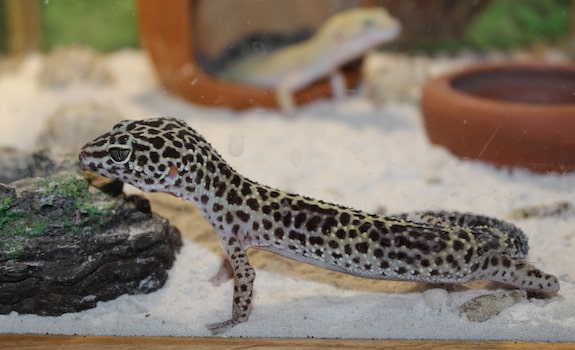
When it comes to your leopard gecko’s substrate, or essentially the “flooring” of their habitat, you’ll have a couple of options.
All of these options essentially fall into one of two categories: Loose (think sand) or non-particle (i.e. “solid”) substrate.
However, one thing to note is the potential for impaction with loose substrates…
Depending on who you ask, you might be told that one of the most essential rules of leopard gecko husbandry is NO loose substrate! Many gecko owners have lost their beloved pet after it ate its own substrate and died from a digestive tract impaction.
And although this sounds scary, it IS possible to use loose substrate successfully IF you take the right precautions.
Now, if you’re new to leopard geckos or you simply prefer to play it safe, then you’ll have several non-particle based substrate options to consider!
Some ideal and easy to manage choices include:
- Tiles
- Newspaper
- Paper towels
- Shelf liner
- Reptile carpet
Now, none of these options are PERFECT, they each have their own pros and cons.
Also, there are other substrate choices that are more naturalistic BUT require some extra maintenance, a little research, and caution.
In a nutshell, you can essentially either provide a super NATURAL experience your leopard gecko will love and you’ll likely find a little inconvenient OR a more artificial experience your gecko will like/tolerate and you’ll find convenient.
Leopard Gecko Habitat Hides & Decorations
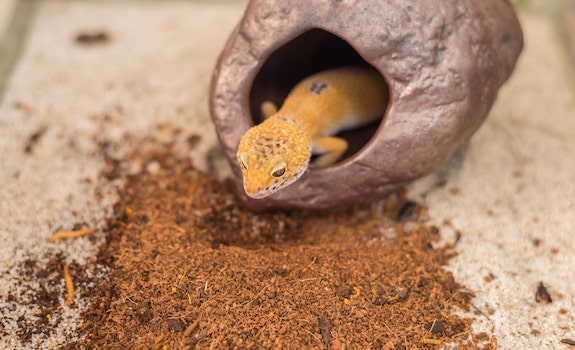
In their native environment, leopard geckos enjoy climbing low-lying rocks, exploring caves, and digging tunnels.
As reptile keepers, we should ALWAYS aim to provide ample enrichment for our pets by giving them hides and decorations that encourage their natural behaviors.
Keep a minimum of three hides in your leopard gecko’s enclosure. One should be on the cool end, and two should be on the warm end. One is its humid hide, and the others are its dry, warm hides.
Leopard geckos feel more secure when they feel the sides of their hide touching their skin. A cozy, tight fit with a small opening is ideal.
Some commercial and custom hides sit flush against the enclosure’s glass wall and have an opening that allows you to see your leopard gecko while it’s trying to hide. This is nifty but may leave your leo feeling exposed, so always offer more secure and dark hides as well.
Of course, your leopard gecko will need a water bowl. This doesn’t need to be very large, and it shouldn’t be deep. Leopard geckos CAN’T swim and aren’t expert climbers.
They’ll also need a bowl for their food. A smooth-sided, deep dish will make it more difficult for some feeder grubs to escape.
Lastly, a third bowl filled with calcium and vitamin D supplement powder can also be made available, especially for growing juveniles!
🤓 Expert Tip: While having the right bowls available is important, you’ll want to make sure you understand the nutritional breakdown of feeders, how much to feed at any given age, what calcium to use, and a few other key leopard gecko diet tips.
All other decorations in the enclosure are up to your personal preferences. Get creative with:
- Cardboard boxes and tubes
- Artificial plants
- Rocks
- Thick branches and driftwood
- Ramps and shelves
- Dig box with loose substrate
- Flat backdrops or 3D foam backgrounds
Leopard geckos enjoy climbing and exploring, but they don’t have the prehensile tails or gripping toes made for it, so keep safety in mind.
Everything in the enclosure should either be low-lying or fall-proof.
If you’re not using a loose substrate, keeping a dig box in the enclosure, separate from its eating area, will allow your leopard gecko to engage his natural burrowing instincts while drastically reducing the impaction risk. Don’t utilize a dig box in a juvenile’s enclosure.
There are numerous online tutorials for building custom foam inserts for terrariums. These can be as simple as a decorative background, or they can include elaborate systems of caves and tunnels for exploration and climbing.
As a final note on decor, anything you use in the enclosure needs to be easy to clean or affordable to throw out and replace if your leopard gecko defecates on it.
Wrapping Up Leopard Gecko Habitat
Leopard geckos are fun, curious, explorative little pets with a ton of personality.
The more effort and care you put into their husbandry, environment, and enrichment needs, the more you will get in return with a healthy, happy leopard gecko that exhibits its natural behaviors for you to watch and enjoy!
As long as you keep their natural environment in mind, and take the necessary safety precautions, you can have a blast and get creative designing your pet’s home.
The MOST important things to remember are:
- Adequate floor space
- Appropriate temperature gradient
- Low humidity
- Three hides, including a humid hide
- The more hides and opportunities for enrichment, the better
- Minimize or eliminate risks for falls, burns, cuts, and impaction
A well-maintained habitat can go a long way to extending your leopard gecko’s lifespan and improve its quality of life.
And as already discussed, an improperly set up enclosure can contribute to shedding problems.
So you can also check out our leopard gecko shedding guide to learn more.
Equipped with a basic understanding of these details, you’re ready to set up your leopard gecko’s perfect enclosure. Have fun!
If you want to learn more about habitats, learn about the White Tree Frog’s here and see how it differs from the one of a Leopard Gecko.
